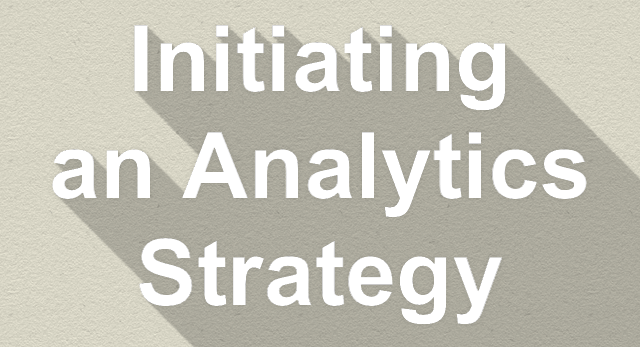Initiating an Analytics Strategy

Do you need an analytics strategy for your healthcare organization?
The importance of provider organizations having an “analytics strategy” was presented in a recent Healthcare IT News article entitled “Do you need an enterprise analytics strategy? It depends. (But probably, yes.)”. The author, Geisinger Chief Data Officer Nicholas Marko, MD says to get the most value out of both technology investments and staff, best practice is to have an “analytics strategy”.
An analytics strategy is a plan, and Dr. Marko notes it is a “dynamic process” in his recent presentation “Unlocking the Door to an Enterprise Analytic Strategy” at the HIMSS Media Big Data & Analytics event in San Francisco. Just saying that your organization “needs analytics, let’s do it” is not a strategy but is an awareness of the need for a strategy.
What is "analytics" and how do I build a strategy for it?
Analytics is an organizational competency and must be nurtured and developed over time. A specific strategy to do this doesn’t have to be complicated or sophisticated but it does need to touch on some key points. Here is a simple 9 point analytics strategy outline for your consideration:
- Vision: How things will look and perform
- Environmental Scan: The drivers and reasons for our vision…the context and why
- Needs & Objectives: What we need and want to accomplish and all the details about it
- Where We Are: The current status of people, processes, technology, and data related to our current situation.
- Where We Want to Go: The target end state goal of what we want to accomplish
- Roadmap: Plan and timeline for bridging the gap between “where we are” and “where we want to go”
- Financial Considerations: The financial and resource impact of our roadmap
- Stakeholders: Who is in charge and whom are they working with
- Terminology: Making sure we are all understanding each other and what we are saying
How do I document my strategy and who needs to play a role?
Documenting the strategy does not have to be laborious or long-winded, a simple 1-2 page plan (even a PowerPoint) will suffice if it has the proper elements.
As part of the analytics strategy development, shop it around the organization to get buy-in and support from all the key players. Invigorate discussion, awareness, and understanding. Involve stakeholders in compromise and tweaks to the plan. These steps will help you progress by building executive support which can lead to additional resources.
What benefits should I expect to see from my analytics strategy?
An organization can expect to see some of these benefits from a socialized analytics strategy…
- A documented collective understanding and purpose for developing analytics
- A common perception of analytics competencies, current and desired capabilities
- A plan for the organization to deliver outcomes for its unified goals
- Technology and staff right-sizing
- Organizational strategic alignment
If I don't want to go it alone, who can help me?
HIMSS Analytics Advisory Services Group offers an ssessment called the Adoption Model for Analytics Maturity (AMAM) and can assist organizations through the process of developing an analytics strategy. The AMAM provides an unbiased healthcare specific roadmap for measuring, adopting, and maturing healthcare analytics. The model focuses on four foundational analytics areas:
- Data content – Building breadth and depth of data
- Infrastructure – Centralizing access and ensuring timeliness of data
- Data governance – Addressing quality, skills management, and strategic alignment
- Analytical competency – Developing talent, socializing standards
Doing a simple AMAM survey can help you understand your organization’s stage in the model. To reveal a firm list of actionable activities you can pursue to advance analytics capabilities, quality, and effectiveness, work with us to complete a full assessment. The AMAM achievement gap report coupled with an analytics assessment will help you develop a strategy that aligns with your healthcare organization's mssion - a powerful combination. For more information on AMAM click here.
